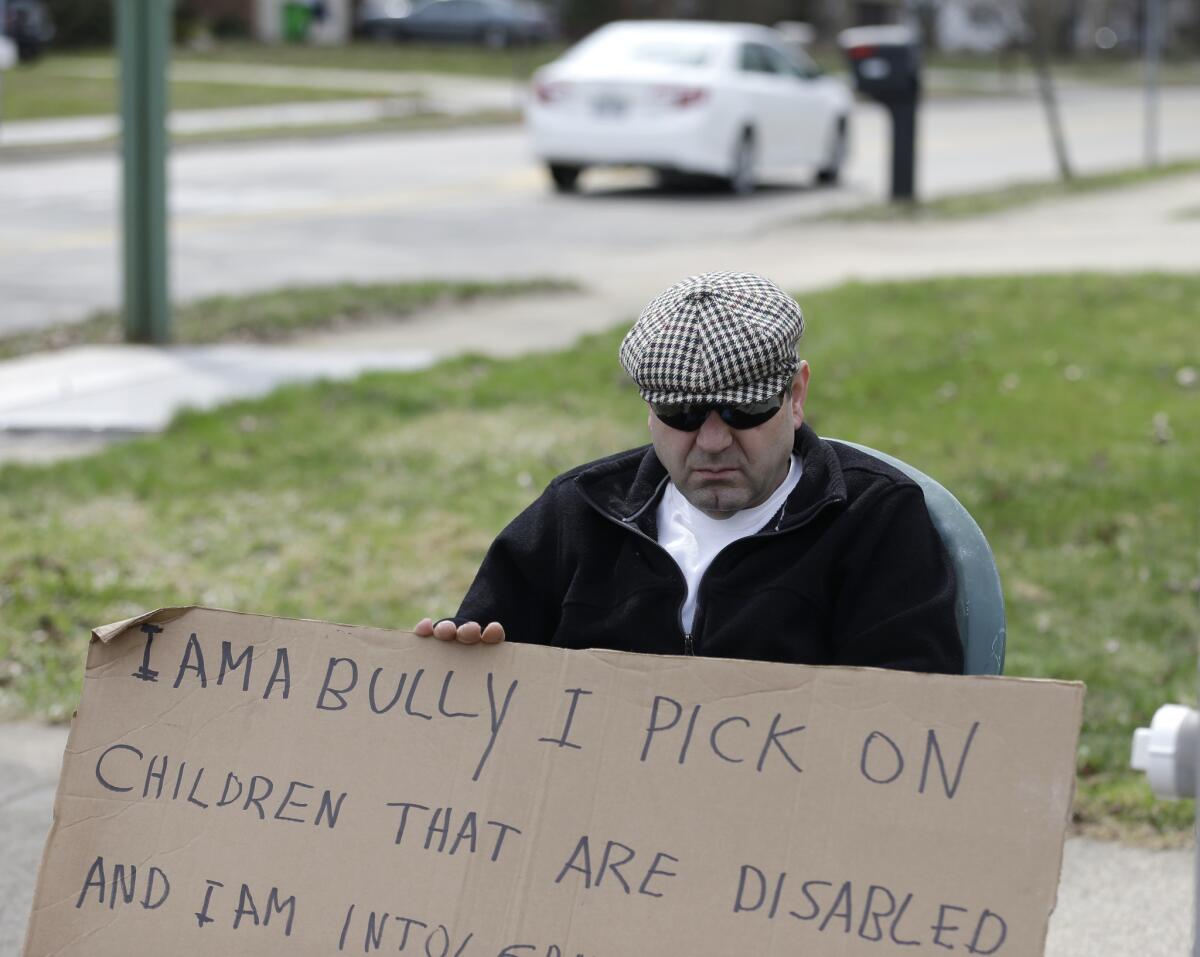Column: Is public shaming fair punishment?

You play the judge: How would you sentence a man who spent 15 years picking on his neighbor and her handicapped children?
A Cleveland judge sentenced just such a man, Edmond Aviv, to jail, community service, anger management and mental health counseling — and to spend five hours alongside a busy street on a Sunday in April with a great big sign branding him an intolerant bully.
The 8th Amendment bans cruel and unusual punishment. Is this either one? Or can justice be fairly meted out in something other than years and months behind bars?
In 2012, a different Cleveland judge gave a woman a choice of going to jail or spending two days standing on a street corner with a sign reading: “Only an idiot would drive on the sidewalk to avoid a school bus.” The woman chose to hold the sign.
Puritan punishments like locking someone’s head and hands in the stocks seem like retribution, not justice. In “The Scarlet Letter,” Hester Prynne, was an adulterer, not a thief. Puritans believed in shame as a behavior corrector. But Prynne flaunted and even co-opted the “A” she was condemned to wear.
Should shame be a component of punishment? Does taking someone down a peg set a miscreant straight, any more than locking him up? And should it be at a judge’s discretion?
A California judge thought so nearly 25 years ago. Visalia Superior Court Judge Howard Broadman made a Prynne analogy when he offered a choice to a Tulare career thief: He could go back to prison for stealing beer or wear a T-shirt for a year that read: “I’m on Felony Probation.... My record plus two six-packs equal four years.”
“[Regular] probation hasn’t worked,” the judge told the felon. “And we have sent you to prison before.” So, “if you are willing to be Hester Prynne for the next year, I am going to give you probation.”
Was it a fair punishment? Let’s call this the Richard Lovelace sentencing question. That poet wrote from prison more than 350 years ago that “Stone walls do not a prison make, / Nor iron bars a cage.”
Broadman seems to have taken that to heart. He sentenced an illiterate woman to learn how to read. Another offender had to donate his car to a battered women’s shelter. And — much ahead of his time — Broadman impounded the cars of repeat drunk drivers.
Yet Broadman triggered a national tripwire in 1991 when a woman came before him with a long criminal record and a felony child abuse conviction for beating her young daughters. The woman was pregnant with her fifth child and, to protect her “un-conceived” children, Broadman gave her a choice: prison or probation using the birth control device Norplant for five years. The woman took the deal — but changed her mind and brought in lawyers.
A confessional T-shirt was one thing; restricting reproduction was another. The ACLU was outraged on the woman’s behalf. Broadman recused himself, and the woman went to prison anyway for violating probation. (I contacted the now-retired Broadman, but he didn’t want to comment on this.)
Judges have sentenced a La Habra slumlord to live in his own run-down building under house arrest for two months, and made an Ohio woman who abandoned 33 kittens spend a night alone in the woods. In a case that made the legal textbooks and withstood appeal in 2005, a San Francisco mail thief was ordered to stand on the post office steps with a sign that read: “I stole mail and this is my punishment.”
It’s hard to track the deterrent effect of such creative punishments because they happen so rarely. And judges have so much power and discretion that creative sentencing could mean wildly and unfairly different punishments for the same crime between one courtroom and the next — one reason that sentencing guidelines and laws exist in the first place.
Daniel Markel, the D’Alemberte professor of law at Florida State University and an expert on sentencing, points out that if these punishments didn’t have some efficacy, “there probably wouldn’t be much resistance” from miscreants, but “in fact defendants typically don’t want to be publicly shamed because they realize there is something publicly humiliating about being exposed in the streets.”
It’s the potential for collateral damage that ought to concern the legal system. “Even the proponents of shaming punishment are leery of the consequences on innocent third parties,” Markel observed. If a sign reading “A violent felon lives here” was posted in front of a man’s house, the felon’s blameless child “might get bullied because of the exposure and humiliation of the father. For some reason prison doesn’t cause the same kind of vivid denunciation that public shamings do.”
The element of choice that comes up in some kinds of creative sentencing might also give us pause. In California and elsewhere, convicted sex offenders have requested castration — chemical and actual — to get out of prison. Civil libertarians object on “cruel and unusual” constitutional grounds, because it amounts to no choice, and because it gets dangerously close to the medieval notion of cutting off a thief’s hands.
Markel adds another objection to asking the guilty to pick their poison: “We punish to communicate censure and condemnation. It’s for a democracy to make those decisions. We ought not empower defendants to be deciding their punishments.”
Edmond Aviv apparently wasn’t given a choice. Will public humiliation change his behavior? He had been convicted of harassment before, so it’s hard to fault the judge for trying something different. And even though we don’t live in Hester Prynne’s world anymore, I’ll cautiously side with the slice of democracy that told a Cleveland.com reporter they approved the sentence.
After all, it “communicated censure and condemnation.” In this case, it seems, a bad guy got his just deserts.
More to Read
A cure for the common opinion
Get thought-provoking perspectives with our weekly newsletter.
You may occasionally receive promotional content from the Los Angeles Times.











